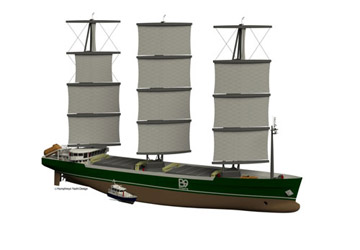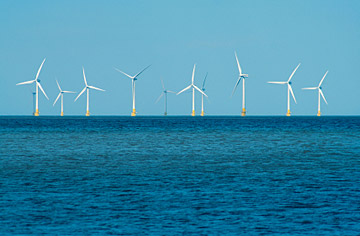Sail Transport – the Return of Sailing Ships?
Rolls Royce invests in advanced hybrid sail and engine powered vessel
Many people look back to the great age of sail, when vessels made of renewable wood and powered by the clean wind moved people and cargo across the world’s oceans. But those days were closed down by the increasing use of coal- and later oil-powered ships. The first “steamships” actually were hybrids, using both coal powered engines, and having sails for use when the wind was favourable or the engine malfunctioned.
Those days may be returning. Rolls-Royce has partnered with B9 Shipping in the building of a new vessel which will use wind power to enhance its engine propulsion which will feature 180-foot sails augmented by bio-methane engines and carrying 4,500 tons of cargo. The objective is 100% renewably-powered commercially and technically-viable sailing hybrid cargo ships.
Craig Taylor, of Rolls-Royce, says,”Rolls-Royce is a leading supplier of marine technology, and has extensive experience in developing advanced propulsion systems. With increased fuel costs and emissions legislation, ship owners and equipment manufacturers are exploring innovative solutions for propulsion and ship design. We have been working closely with B9 Shipping for the past couple of years on their exciting project to develop a new general type of sail powered cargo ships. B9 is proposing the use of our Bergen gas engine range, to provide back-up power for the ship, and we are also collaborating in areas such as hydrodynamics and propulsion.”
The designs have an automated, three mast square rig sail system, and are around 100m long with 55m high masts. This is so that the sail power can be optimised and sails reoriented with the push of a button, thus bringing crew numbers down to the equivalent motor vessel.

The hull design has been tested in a wind tunnel and tank at Southampton University which showed that the fuel consumption would be 46- 55% lower than an equivalent conventional ship on the same route. The designers of the ship believe that it would be clean, effective transport and financially advantageous: “calculations of payback times for added capital costs over the lifetime of a B9 Ship indicate that capitalising on the ‘green’ advantage would see payback on extra capital cost within 3-5 years.”

Jan Lundberg, of the Sail Transport Network, a group who are in the forefront of experiments to push forward environmentally friendly shipping, says, “The positive trend in readying the transitioning global trading economy is discernible, shown by the new partnership of Rolls Royce and B9 Shipping. We at Sail Transport Network are encouraged by this and many other projects, mostly small, that tell us the New Age of Sail is dawning. After all, since conventional oil extraction peaked several years ago, and we are losing the comfortable climate humanity had gotten used to, there is more widespread urgency to pursue trade and travel in more efficient, safer ways.”
Visit GreenJobs for the latest Marine Jobs.




Clearly a brilliant idea and totally impressive technology. Sadly its commercial introduction is liable to be delayed until dirty fossil fuels also become very expensive.